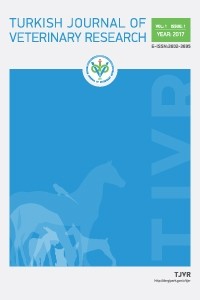The study of some hematologic and biochemical parameters in chickens vaccinated with inactivated dual Newcastle-Influenza vaccine
The study of some hematologic and biochemical parameters in chickens vaccinated with inactivated dual Newcastle-Influenza vaccine
Results: The results showed that the values of biochemical parameters such as albumin, glucose, total protein, triglyceride, cholesterol, ALT, AST, and ALP enzymes, sodium and potassium minerals, and hematocrit and hemoglobin levels in vaccinated and non-vaccinated chickens were not significantly different. Also, in chickens injected with antigen, Newcastle disease and influenza antibody titers were significantly different with those groups containing adjuvant. Materials and Methods: In this study, after subcutaneous and intramuscular inoculation of inactivated dual oil emulsion Newcastle-Influenza vaccine, the serum antibody level and hematobiochemical factors of these avian were analyzed on 7, 14, 21, and 28 days after vaccine injection. Objective: Newcastle and Influenza diseases are important viral diseases and its occurrence and virulence in Iran has increased in recent years. The purpose of this study was to evaluate the humoral immune responses of chickens vaccinated with inactivated dual oil emulsion Newcastle disease and avian influenza vaccine in two methods of intramuscular and subcutaneous injection as well as to assess the possible changes in serum biochemical factors. Conclusion: The results of this study indicate that the intramuscular and subcutaneous injection of dual combination vaccine is similar in terms of changes in biochemical and hematological factors and Newcastle disease and influenza antibody titers. To ensure safety in inactivated vaccines, the presence of proper adjuvant is essential for immune response.
Keywords:
Avian influenza virus, Newcastle virus, biochemical factors,
___
- Abraham A, Sivanandan V, Halvorson D.A. and Newman J.A. Standardization of enzyme linked immunosorbent assay for avian influenza virus antibodies in turkeys. Am J Vet Res, 1986;47: 561–566Adair B. M, McNulty M.S, Todd D, Connor T.J, Burns K. Quantitive estimation of Newcastle disease virus antibody levels in chickens and turkeys by ELISA. Avian Pathology. 1989;18:175-192.Aguilar JC, Rodriguez EG. Vaccine adjuvants revisited. Vaccine. 2007;25(19): 3752-62.Alexander, Y., Alekseee, v., Kirill, A., Sharsho, v., Vasiliy, Y., Marchenko, Zhuo Li. Antibodies to Newcastle Disease Virus in Egg Yolks of Great Cormorant (Phalacrocorax carbo) at Qinghai Lake, Advances in Infectious Diseases. 2014;4:194-197.Alizadeh-Arsi, L., Hoshyari, A., Ameghi-Roodsary, A., Ghaniei, A., jafari, B., Jafari sales, A. Evaluation of Antibody Titer Changes Against Newcastle Disease and influenza (H9N2) In The Egg Yolk During Incubation Period and its Impact on The Replication of the Viruses. New Findings in Veterinary Microbiology, 2018; 1(1): 15-27.Beard, C.W. and Easterday, B.C.; A Turkey Oregon 71, an avirulent influenza isolate with the hemagglutinin of fowl plague virus. Avian Diseases. 1973;17: 173–181.Dolin R, Reichman R.C, Madore H.P, Maynard R, Linton P.N, Webber Jones J. A controlled trial of amantadine and rimantadine in the prophylaxis of influenza A infection. N. Engl. J. Med. 1982;307:580–584.Easterday B.C, Hinshaw V.S, Halvorson D.A. Influenza. In: Calnek, B.W.; Barnes, H.J.; Beard, C.W.; McDougald, L.R. and Saif, Y.M. (eds.). Diseases of Poultry, 10th edition, 1997;583–605 (Iowa State University Press Ltd).EFSA. Animal health and welfare aspects of avian influenza. EFSA Journal. 2005;266: 1–21.Guan Y, Shortridge K.F, Krauss S, Webster R.G. Molecular characterization of H9N2 influenza viruses: were they the donors of the "internal" genes of H5N1 viruses in Hong Kong, Proceedings of the National Academy of Sciences. 1999;96: 9363-9367.Iqbal M, Yaqub T, Mukhtar N, Shabbir, M.Z, McCauley J.W. Infectivity and transmissibility of H9N2 avian influenza virus in chickens and wild terrestrial birds, Vet. Res. 2013;44:100.Kudair I.M. and Al-Hussary N.A.J. Effect of vaccination on some biochemical parameters in broiler chickens. Iraqi J. Vet. Sci. 2010;24(2):59-64. Lang G, Narayan O, Rouse B.T. Prevention of malignant avian influenza by 1-adamantanamine hydrochloride. Archiv fur die Gesamte Virusforschung. 1970;32:171–184.Nidhin R, Praseena P, Surya P.S, Chintu R, Mathew S. comparison of antibody titres of newcastle disease virus in randomly collected sera and egg yolk of layers. J. Vet. Anim.Sci. 2009;40:20-21.Palmer D.F, Coleman M.T, Dowdle W.D, Schild G.O. Advanced laboratory techniques for influenza diagnosis. Immunology series no. 6. U.S. Department of Health, Education and Welfare, Public Health Service, Centers of Disease Control: Atlanta, GA. 1975.Silva, B. C., Martins, M. L., Jatobá, A., Buglione Neto, C. C., Vieira, F. N., Pereira, G. V., ... & Mouriño, J. L. P. Hematological and immunological responses of Nile tilapia after polyvalent vaccine administration by different routes. Pesquisa Veterinária Brasileira, 2009;29(11), 874-880Swayne D.E, King D.J. Avian influenza and Newcastle disease. J Am Vet Med Assoc. 2003;222(11):1534–1540.Talebi A. Biochemical Parameters in Broiler Chickens Vaccinated Against ND, IB and IBD. Int J Poultry Sci. 2006;5(12): 1151-1155.Trampel DW, Zhou EM, Yoon KJ, Koehler KJ. Detection of antibodies in serum and egg yolk following infection of chickens with an H6N2 avian influenza virus. J Vet Diagn Invest. 2006;18:437–442.Van Deusen, R.A.; Hinshaw, V.S.; Senne, D.A. and Pellacani, D. Micro neuraminidase inhibition assay for classification of influenza A virus neuraminidases. Avian Diseases. 1983;27:745-750.Webster R.G, Kawaoka Y, Bean W.J, Beard C.W, Brugh M. Chemotherapy and vaccination: A possible strategy for the control of highly virulent influenza virus. Journal of Virology. 1985;55: 173-176.
- Başlangıç: 2017
- Yayıncı: Ebubekir CEYLAN
Sayıdaki Diğer Makaleler
Mehdi EZDİYADİ, Ali Akbar ABOLFATHİ, Aref HOSHYARİ, Abolfazl JAFARİ-SALES, Farhad FARHADİ
Abdelhanine AYAD, Priya YUVARAJU, Sumaya BEEGAM, Abderrahim NEMMAR
A Case of Pyometra in a 5-Month-Old Cat
Arzu ESEN, Merve Menekşe YİLDİRİM, Berfin KAHRAMAN, Özgenur KAFKAS, Ezgi DİKMEOĞLU, İpek MUTLUER
Anatomic Characteristics and Locations of Nutrient Foramen in Humerus of Domestic Animals
Characterization in Two Indonesian Bos indicus Cattle Breeds Based on Morphometrical Measurements
